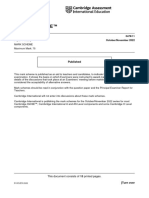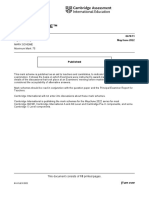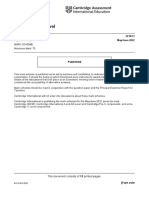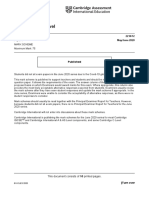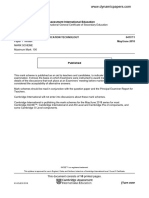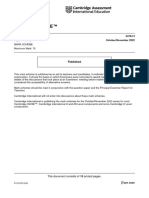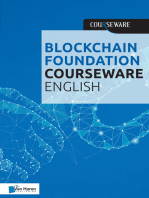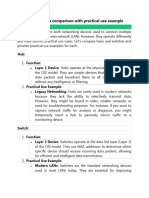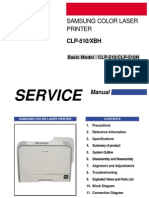Cambridge IGCSE ™: Computer Science 0478/12 October/November 2022
Cambridge IGCSE ™: Computer Science 0478/12 October/November 2022
Uploaded by
nathanmotha1Copyright:
Available Formats
Cambridge IGCSE ™: Computer Science 0478/12 October/November 2022
Cambridge IGCSE ™: Computer Science 0478/12 October/November 2022
Uploaded by
nathanmotha1Original Title
Copyright
Available Formats
Share this document
Did you find this document useful?
Is this content inappropriate?
Copyright:
Available Formats
Cambridge IGCSE ™: Computer Science 0478/12 October/November 2022
Cambridge IGCSE ™: Computer Science 0478/12 October/November 2022
Uploaded by
nathanmotha1Copyright:
Available Formats
Cambridge IGCSE™
COMPUTER SCIENCE 0478/12
Paper 1 Theory October/November 2022
MARK SCHEME
Maximum Mark: 75
Published
This mark scheme is published as an aid to teachers and candidates, to indicate the requirements of the
examination. It shows the basis on which Examiners were instructed to award marks. It does not indicate the
details of the discussions that took place at an Examiners’ meeting before marking began, which would have
considered the acceptability of alternative answers.
Mark schemes should be read in conjunction with the question paper and the Principal Examiner Report for
Teachers.
Cambridge International will not enter into discussions about these mark schemes.
Cambridge International is publishing the mark schemes for the October/November 2022 series for most
Cambridge IGCSE™, Cambridge International A and AS Level components and some Cambridge O Level
components.
This document consists of 13 printed pages.
© UCLES 2022 [Turn over
0478/12 Cambridge IGCSE – Mark Scheme October/November 2022
PUBLISHED
Generic Marking Principles
These general marking principles must be applied by all examiners when marking candidate answers. They should be applied alongside the
specific content of the mark scheme or generic level descriptors for a question. Each question paper and mark scheme will also comply with these
marking principles.
GENERIC MARKING PRINCIPLE 1:
Marks must be awarded in line with:
• the specific content of the mark scheme or the generic level descriptors for the question
• the specific skills defined in the mark scheme or in the generic level descriptors for the question
• the standard of response required by a candidate as exemplified by the standardisation scripts.
GENERIC MARKING PRINCIPLE 2:
Marks awarded are always whole marks (not half marks, or other fractions).
GENERIC MARKING PRINCIPLE 3:
Marks must be awarded positively:
• marks are awarded for correct/valid answers, as defined in the mark scheme. However, credit is given for valid answers which go beyond the
scope of the syllabus and mark scheme, referring to your Team Leader as appropriate
• marks are awarded when candidates clearly demonstrate what they know and can do
• marks are not deducted for errors
• marks are not deducted for omissions
• answers should only be judged on the quality of spelling, punctuation and grammar when these features are specifically assessed by the
question as indicated by the mark scheme. The meaning, however, should be unambiguous.
GENERIC MARKING PRINCIPLE 4:
Rules must be applied consistently, e.g. in situations where candidates have not followed instructions or in the application of generic level
descriptors.
© UCLES 2022 Page 2 of 13
0478/12 Cambridge IGCSE – Mark Scheme October/November 2022
PUBLISHED
GENERIC MARKING PRINCIPLE 5:
Marks should be awarded using the full range of marks defined in the mark scheme for the question (however; the use of the full mark range may
be limited according to the quality of the candidate responses seen).
GENERIC MARKING PRINCIPLE 6:
Marks awarded are based solely on the requirements as defined in the mark scheme. Marks should not be awarded with grade thresholds or
grade descriptors in mind.
Please note the following further points:
The words in bold in the mark scheme are important text that needs to be present, or some notion of it needs to be present. It does not have to
be the exact word, but something close to the meaning.
If a word is underlined, this exact word must be present.
A single forward slash means this is an alternative word. A double forward slash means that this is an alternative mark point.
Ellipsis (…) on the end of one-mark point and the start of the next means that the candidate cannot get the second mark point without being
awarded the first one. If a mark point has an ellipsis at the beginning, but there is no ellipsis on the mark point before it, then this is just a follow-on
sentence and can be awarded without the previous mark point.
© UCLES 2022 Page 3 of 13
0478/12 Cambridge IGCSE – Mark Scheme October/November 2022
PUBLISHED
Question Answer Marks
1(a) Any two from: 2
• Keyboard
• Trackpad
• Trackball
• Microphone
• Keypad
• Sensor
• Button
• Barcode/QR scanner/reader
• Webcam/digital camera
1(b) Any one from: 1
• Speaker
• Headphones
1(c)(i) Any four from: 4
• The screen is made up of (two) layers/multiple layers
• The user pushes the top layer into the bottom layer // The user pushes the layers together
• The layers create a circuit (when pushed together)
• causing electricity to flow
• allowing the co-ordinates/location of the users touch to be calculated
1(c)(ii) Any two from: 2
• Cheap to manufacture/buy
• Can still be used whilst wearing gloves
• Waterproof // Can be used in bad weather
• Does not easily shatter
• Low power consumption
• (Can) support multitouch
© UCLES 2022 Page 4 of 13
0478/12 Cambridge IGCSE – Mark Scheme October/November 2022
PUBLISHED
Question Answer Marks
1(c)(iii) Any two from: 2
• Does not (normally) support multitouch
• Screen visibility can be poor in sunlight
• Longevity issues
• (Normally) lower resolution
• Not very sensitive to touch // Lower response time (than capacitive)
• Prone to scratches
1(c)(iv) Any one from: 1
• Capacitive
• Infrared
1(d) Any two from: 2
• Data and instructions are stored in the same memory
• and can only be fetched one at a time
1(e) Any three from: 3
• Multitasking
• Multiprogramming
• Input and output control
• Running software
• Memory management
• Processor management
• File management
• Handling interrupts
• Providing security
• Managing user accounts
• Batch / real-time processing
© UCLES 2022 Page 5 of 13
0478/12 Cambridge IGCSE – Mark Scheme October/November 2022
PUBLISHED
Question Answer Marks
1(f)(i) • 000001100100 3
• 000011101011
• 000100101101
1(f)(ii) • 22 3
• 119
• 857
1(f)(iii) One mark for two correct characters in the correct place, two marks for three 4
• 095
• AD1
© UCLES 2022 Page 6 of 13
0478/12 Cambridge IGCSE – Mark Scheme October/November 2022
PUBLISHED
Question Answer Marks
2(a) Six from: 6
• Motion/proximity/infra-red sensor is used
• Sensor sends data to microprocessor
• Data is converted from analogue to digital (using ADC)
• Data is compared to stored/set value(s)
• If data is inside range/outside range/greater than/less than, signal is sent to turn water tap on
• If data is outside range /inside range/less than/greater than, tap remains off / signal is sent to turn water tap off
• Actuator is used to turn the tap off/on
• Whole process is continuous
2(b) One mark for each correct sensor 3
Description of system Sensor
it checks the air is dry enough in a garage that spray paints Moisture/humidity
cars
it automatically switches on the headlights on a car when it is Light
dark
it checks that the soil in a greenhouse has the correct level of pH
acidity
© UCLES 2022 Page 7 of 13
0478/12 Cambridge IGCSE – Mark Scheme October/November 2022
PUBLISHED
Question Answer Marks
3 One mark for each correct row 5
Component
Statement RAM Internal USB flash
(✓) SSD memory drive
(✓) (✓)
it is a type of primary storage ✓
it is volatile ✓
it uses NAND and NOR technology ✓ ✓
it does not have any moving parts ✓ ✓ ✓
it is not directly connected to the ✓ ✓
Central Processing Unit (CPU)
© UCLES 2022 Page 8 of 13
0478/12 Cambridge IGCSE – Mark Scheme October/November 2022
PUBLISHED
Question Answer Marks
4 One mark for the method, one mark for a corresponding description 4
• Create a back-up
• this means the data can be restored/recovered
• Add verification
• to get the user to confirm they want to delete the data
• Set access rights
• so that she cannot delete any files
© UCLES 2022 Page 9 of 13
0478/12 Cambridge IGCSE – Mark Scheme October/November 2022
PUBLISHED
Question Answer Marks
5 One mark each for the correct byte and bit 4
• Byte 4
• Bit 5
Any two from:
• Counted all the 1s
• An even parity has been used
• Odd number of ones in that row (byte 4) and column (bit 5)
© UCLES 2022 Page 10 of 13
0478/12 Cambridge IGCSE – Mark Scheme October/November 2022
PUBLISHED
Question Answer Marks
6(a) Any two from: 2
• Check if web address starts with HTTPS
• Check if there is a locked padlock
• Check the digital certificate for the website
6(b) • Transport layer security // TLS 1
6(c) Any four from: 4
• To act as intermediary between browser and web server
• to filter/examine/monitor traffic to the web server
• to help stop malicious traffic to the web server
• To cache frequently viewed web pages
• to allow faster response time for requests
• to reduce the number of requests the server needs to process
• To help prevent DoS
• stopping the webserver being overloaded with requests
• by redirecting away from server // by stopping DoS attack reaching server
• To act as a firewall
6(d)(i) • Spyware 1
© UCLES 2022 Page 11 of 13
0478/12 Cambridge IGCSE – Mark Scheme October/November 2022
PUBLISHED
Question Answer Marks
6(d)(ii) One mark for a correct method, one mark for a corresponding description 6
• Drop down boxes
• this means that the keypresses cannot be recorded
• Onscreen/virtual keyboard
• this means that the keypresses cannot be recorded
• Biometrics // by example
• this means that the keypresses cannot be recorded
• no password entered to be gathered
• Anti-malware // anti-spyware
• this will scan for/remove any malware that could be recording keypresses
• Random/select values requested from password
• this means that full password cannot be obtained (in a single login)
• Firewall
• to prevent the download of any malware that could gather keypresses
6(e) One mark for each correct term in the correct order 6
• URL
• IP address
• Web server
• Web pages
• HTML
• Browser
© UCLES 2022 Page 12 of 13
0478/12 Cambridge IGCSE – Mark Scheme October/November 2022
PUBLISHED
Question Answer Marks
7(a) One mark for each correct row 4
NAND OR XOR
Statement
(✓) (✓) (✓)
if both inputs are 1, the output is 1 ✓
if both inputs are different from each other, the output is 1 ✓ ✓ ✓
if both inputs are 0, the output is 0 ✓ ✓
if both inputs are the same as each other, the output is always 0 ✓
7(b) One mark for a correct logic gate, one mark for a corresponding truth table 2
• AND
A B Output
0 0 0
0 1 0
1 0 0
1 1 1
© UCLES 2022 Page 13 of 13
You might also like
- Cambridge O Level: Computer Science 2210/12 October/November 2022Document13 pagesCambridge O Level: Computer Science 2210/12 October/November 2022maymoona shahidNo ratings yet
- Cambridge IGCSE ™: Information & Communication Technology 0417/11Document9 pagesCambridge IGCSE ™: Information & Communication Technology 0417/11eyadmohdsam09No ratings yet
- Cambridge IGCSE ™: Computer Science 0478/11 October/November 2022Document15 pagesCambridge IGCSE ™: Computer Science 0478/11 October/November 2022senurap50No ratings yet
- Cambridge IGCSE ™: Information & Communication Technology 0417/11Document9 pagesCambridge IGCSE ™: Information & Communication Technology 0417/11babsiesmith8No ratings yet
- Cambridge IGCSE™: Information & Communication Technology 0417/11Document9 pagesCambridge IGCSE™: Information & Communication Technology 0417/11Rinoa HermanNo ratings yet
- Cambridge IGCSE™: Computer Science 0478/11 May/June 2022Document13 pagesCambridge IGCSE™: Computer Science 0478/11 May/June 2022Tiyané ChigavaziraNo ratings yet
- Cambridge O Level: Computer Science 2210/11 May/June 2022Document13 pagesCambridge O Level: Computer Science 2210/11 May/June 2022Shaheer SheryNo ratings yet
- Cambridge IGCSE™: Computer Science 0478/12 February/March 2022Document13 pagesCambridge IGCSE™: Computer Science 0478/12 February/March 2022REENA SNNo ratings yet
- Cambridge International AS & A Level: Computer Science 9608/12 May/June 2020Document9 pagesCambridge International AS & A Level: Computer Science 9608/12 May/June 2020Zaki JrNo ratings yet
- Cambridge IGCSE™: Computer Science 0478/12 October/November 2020Document13 pagesCambridge IGCSE™: Computer Science 0478/12 October/November 2020boyredbisonNo ratings yet
- Cambridge IGCSE™: Information & Communication Technology 0417/12 October/November 2021Document9 pagesCambridge IGCSE™: Information & Communication Technology 0417/12 October/November 2021EffNo ratings yet
- Cambridge O Level: Computer Science 2210/12 May/June 2020Document10 pagesCambridge O Level: Computer Science 2210/12 May/June 2020Mashrur RahmanNo ratings yet
- Cambridge International AS & A Level: Computer Science 9608/12 May/June 2020Document9 pagesCambridge International AS & A Level: Computer Science 9608/12 May/June 2020Shanbhavi ShanmugarajahNo ratings yet
- Oct:nov 2022 P11Document10 pagesOct:nov 2022 P11qzpympdd9nNo ratings yet
- Cambridge International AS & A Level: Computer Science 9618/31 May/June 2022Document11 pagesCambridge International AS & A Level: Computer Science 9618/31 May/June 2022Xcomwifi Private Business CorporationNo ratings yet
- Cambridge International AS & A Level: Computer Science 9618/12Document11 pagesCambridge International AS & A Level: Computer Science 9618/12heerahsheyenneNo ratings yet
- Cambridge International AS & A Level: Computer Science 9618/21 October/November 2021Document11 pagesCambridge International AS & A Level: Computer Science 9618/21 October/November 2021Bilal Ahmad KhanNo ratings yet
- Cambridge IGCSE ™: Information & Communication Technology 0417/13 October/November 2022Document9 pagesCambridge IGCSE ™: Information & Communication Technology 0417/13 October/November 2022vibinkings761No ratings yet
- 0510 - w22 - Ms - 23 PaperDocument11 pages0510 - w22 - Ms - 23 Papersinghnidhi.dNo ratings yet
- Cambridge IGCSE™: Information and Communication Technology 0417/13 May/June 2022Document15 pagesCambridge IGCSE™: Information and Communication Technology 0417/13 May/June 2022imran MalikNo ratings yet
- Cambridge IGCSE™: Information and Communication Technology 0417/13 May/June 2022Document15 pagesCambridge IGCSE™: Information and Communication Technology 0417/13 May/June 2022Tlhokomelo SetholeNo ratings yet
- Cambridge IGCSE ™: English As A Second Language 0510/23 October/November 2022Document11 pagesCambridge IGCSE ™: English As A Second Language 0510/23 October/November 2022Penang Home TuitionNo ratings yet
- Cambridge IGCSE™: Computer Science 0478/11 May/June 2020Document11 pagesCambridge IGCSE™: Computer Science 0478/11 May/June 2020Miguel Oubiña SánchezNo ratings yet
- Var 2 MSDocument11 pagesVar 2 MSamouryh2019No ratings yet
- Cambridge Assessment International Education: Information and Communication Technology 0417/11 May/June 2018Document10 pagesCambridge Assessment International Education: Information and Communication Technology 0417/11 May/June 2018SimonaNo ratings yet
- Cambridge IGCSE™: Computer Science 0478/12 May/June 2020Document10 pagesCambridge IGCSE™: Computer Science 0478/12 May/June 2020SF GohNo ratings yet
- November 2020 Mark Scheme Paper 21Document22 pagesNovember 2020 Mark Scheme Paper 21parealTGS GamingNo ratings yet
- Cambridge IGCSE™: Computer Science 0478/12 May/June 2021Document8 pagesCambridge IGCSE™: Computer Science 0478/12 May/June 2021AwadNo ratings yet
- Cambridge O Level: Computer Science 2210/12 October/November 2021Document12 pagesCambridge O Level: Computer Science 2210/12 October/November 2021shabanaNo ratings yet
- Cambridge Assessment International Education: Computer Science 9608/13 May/June 2019Document10 pagesCambridge Assessment International Education: Computer Science 9608/13 May/June 2019Ridee RekaNo ratings yet
- Cambridge International AS & A Level: Computer Science 9618/12Document11 pagesCambridge International AS & A Level: Computer Science 9618/12Om surya DodejaNo ratings yet
- Cambridge International AS & A Level: Information Technology 9626/13 October/November 2021Document11 pagesCambridge International AS & A Level: Information Technology 9626/13 October/November 2021Riaz KhanNo ratings yet
- Cambridge Assessment International Education: Computer Science 9608/13 May/June 2019Document10 pagesCambridge Assessment International Education: Computer Science 9608/13 May/June 2019Shafeeque AhmedNo ratings yet
- 9626_w24_ms_12Document9 pages9626_w24_ms_12S.V. CREATIONSNo ratings yet
- Cambridge International AS & A Level: Computer Science 9608/13 May/June 2020Document9 pagesCambridge International AS & A Level: Computer Science 9608/13 May/June 2020Zaki JrNo ratings yet
- Cambridge O Level: Computer Science 2210/12 May/June 2021Document8 pagesCambridge O Level: Computer Science 2210/12 May/June 2021Sweta YoshitaNo ratings yet
- June 2021 Paper 42 Mark SchemeDocument11 pagesJune 2021 Paper 42 Mark Schemephiwayinkhosikhumalo854No ratings yet
- Cambridge O Level: Computer Science For Examination From 2023Document10 pagesCambridge O Level: Computer Science For Examination From 2023Ms. SewdineNo ratings yet
- Cambridge IGCSE™: Information and Communication Technology 0417/13 May/June 2022Document15 pagesCambridge IGCSE™: Information and Communication Technology 0417/13 May/June 2022ilovefettuccineNo ratings yet
- Cambridge International AS & A Level: Computer Science 9618/13Document10 pagesCambridge International AS & A Level: Computer Science 9618/13Om surya DodejaNo ratings yet
- Cambridge O Level: Computer Science 2210/12Document10 pagesCambridge O Level: Computer Science 2210/12shayanahmed1212No ratings yet
- Cambridge IGCSE™: Computer Science 0478/13Document10 pagesCambridge IGCSE™: Computer Science 0478/13Abraham AsifNo ratings yet
- Cambridge AS Level November-2020-Mark-Scheme-Paper-02Document14 pagesCambridge AS Level November-2020-Mark-Scheme-Paper-02johnastsang2013No ratings yet
- Cambridge IGCSE ™: Design & Technology 0445/13 October/November 2022Document10 pagesCambridge IGCSE ™: Design & Technology 0445/13 October/November 2022ayomikun.chiamaka.adekeyeNo ratings yet
- Cambridge IGCSE™: Information and Communication Technology 0417/11Document9 pagesCambridge IGCSE™: Information and Communication Technology 0417/11hamandishenicole3No ratings yet
- Cambridge IGCSE ™: Computer Science 0478/13 October/November 2022Document15 pagesCambridge IGCSE ™: Computer Science 0478/13 October/November 2022ONo ratings yet
- Cambridge IGCSE™: Design and Technology 0445/13 October/November 2020Document10 pagesCambridge IGCSE™: Design and Technology 0445/13 October/November 2020thana.pNo ratings yet
- Cambridge International AS & A Level: Computer Science 9618/13 October/November 2022Document10 pagesCambridge International AS & A Level: Computer Science 9618/13 October/November 2022Steven ShemdoeNo ratings yet
- 9626_w24_ms_32Document15 pages9626_w24_ms_32S.V. CREATIONSNo ratings yet
- Cambridge International AS & A Level: Computer Science 9618/13 October/November 2021Document9 pagesCambridge International AS & A Level: Computer Science 9618/13 October/November 2021marwahaltahanNo ratings yet
- Cambridge IGCSE™: First Language English 0500/12 February/March 2022Document22 pagesCambridge IGCSE™: First Language English 0500/12 February/March 2022ALI SAJIDNo ratings yet
- Cambridge IGCSE ™: Computer Science 0478/12Document10 pagesCambridge IGCSE ™: Computer Science 0478/12zoyaNo ratings yet
- 0478 m22 Ms 12....Document13 pages0478 m22 Ms 12....agentm398No ratings yet
- 9626_w24_ms_11Document9 pages9626_w24_ms_11S.V. CREATIONSNo ratings yet
- 2210 w18 Ms 12Document12 pages2210 w18 Ms 12Fiyazul HaqueNo ratings yet
- Cambridge IGCSE ™: Design & Technology 0445/12Document10 pagesCambridge IGCSE ™: Design & Technology 0445/12Ali SiddiqNo ratings yet
- June 2021 Mark Scheme Paper 11Document8 pagesJune 2021 Mark Scheme Paper 11Omar BilalNo ratings yet
- Number 4 (0654 - w22 - Ms - 42)Document13 pagesNumber 4 (0654 - w22 - Ms - 42)Muhammad Luthfansyah PrabowoNo ratings yet
- Cambridge IGCSE ™: Design & Technology 0445/12 October/November 2022Document10 pagesCambridge IGCSE ™: Design & Technology 0445/12 October/November 2022ayomikun.chiamaka.adekeyeNo ratings yet
- Module 05Document35 pagesModule 05carloschica480No ratings yet
- Development of Fire Alarm System Using Raspberry Pi and Arduino UnoDocument7 pagesDevelopment of Fire Alarm System Using Raspberry Pi and Arduino UnoTanimunNo ratings yet
- Electronic 5S: An Introduction To Digital Workplace OrganizationDocument32 pagesElectronic 5S: An Introduction To Digital Workplace Organizationjemal yahyaaNo ratings yet
- Number System 1Document35 pagesNumber System 1Aka Monu100% (1)
- Computer Science Notes Class 7th CH No 1Document4 pagesComputer Science Notes Class 7th CH No 1Naveed AfzalNo ratings yet
- Vim Cheat Sheet For Programmers PrintDocument1 pageVim Cheat Sheet For Programmers PrintK Kunal RajNo ratings yet
- Red Hat Enterprise Linux-7-Load Balancer AdministrationDocument50 pagesRed Hat Enterprise Linux-7-Load Balancer AdministrationYoelkys Beltrán SánchezNo ratings yet
- People Ware Firmware Software HardwareDocument5 pagesPeople Ware Firmware Software HardwareYne AhuninNo ratings yet
- Database-Introduction-Installation-Guide-Win7Document5 pagesDatabase-Introduction-Installation-Guide-Win7ads adsNo ratings yet
- Datasheet WTV020SD PDFDocument26 pagesDatasheet WTV020SD PDFMateusKomsNo ratings yet
- DP Misc 15044 DriversDocument1,387 pagesDP Misc 15044 DriversRajesh1146No ratings yet
- Dumpsys ANR WindowManagerDocument1,707 pagesDumpsys ANR WindowManagerPamela Mamani RomeroNo ratings yet
- Microprocessor (210254)Document12 pagesMicroprocessor (210254)Prathamesh BhagatNo ratings yet
- Mag Pi 144Document100 pagesMag Pi 144kursadNo ratings yet
- Twitter, Pig, and HBase. For Bay Area Hadoop User Group May 2010Document28 pagesTwitter, Pig, and HBase. For Bay Area Hadoop User Group May 2010squarecog100% (1)
- Hub Versus Switch Comparison With Practical Use ExampleDocument3 pagesHub Versus Switch Comparison With Practical Use Examplewinbenitez123No ratings yet
- MCQ of C++Document3 pagesMCQ of C++Anik91% (11)
- NutanixDocument162 pagesNutanixJos JacksonNo ratings yet
- Mi 4Document61 pagesMi 4capybara3124No ratings yet
- Cisco Nexus 9000v 9300v 9500v Guide 93xDocument50 pagesCisco Nexus 9000v 9300v 9500v Guide 93xkaralyhNo ratings yet
- Advanced Binary Deobfuscation PDFDocument136 pagesAdvanced Binary Deobfuscation PDFkougaR8No ratings yet
- DS1245Y/AB 1024k Nonvolatile SRAM: Features Pin AssignmentDocument3 pagesDS1245Y/AB 1024k Nonvolatile SRAM: Features Pin AssignmentDel ValleNo ratings yet
- Informatica Interview Question Answers CollectionDocument4 pagesInformatica Interview Question Answers CollectionSweta SinghNo ratings yet
- AOMEI BackupperDocument20 pagesAOMEI Backuppericyman_petrosNo ratings yet
- Excel 2003 - CompleteDocument387 pagesExcel 2003 - CompleteRazvan PetrariuNo ratings yet
- 1 - LanguagefundamentalsDocument13 pages1 - LanguagefundamentalsJack BrownNo ratings yet
- Samsung Color Laser Printer CLP 510 510N Parts and Service ManualDocument227 pagesSamsung Color Laser Printer CLP 510 510N Parts and Service Manualmehdi_palangiNo ratings yet
- DataSheet Enterprise Security Gateway and Network Appliance With 10G SFP+ Ubiquiti UniFi Dream Machine PRO UDM-PRO PDFDocument7 pagesDataSheet Enterprise Security Gateway and Network Appliance With 10G SFP+ Ubiquiti UniFi Dream Machine PRO UDM-PRO PDFPlanetNo ratings yet
- Xerox Phaser 3100MFP Service Manual RUSDocument257 pagesXerox Phaser 3100MFP Service Manual RUSvvvvzzzzzNo ratings yet
- Bypass Av Dynamics (NEW)Document21 pagesBypass Av Dynamics (NEW)IvanOozeNo ratings yet


